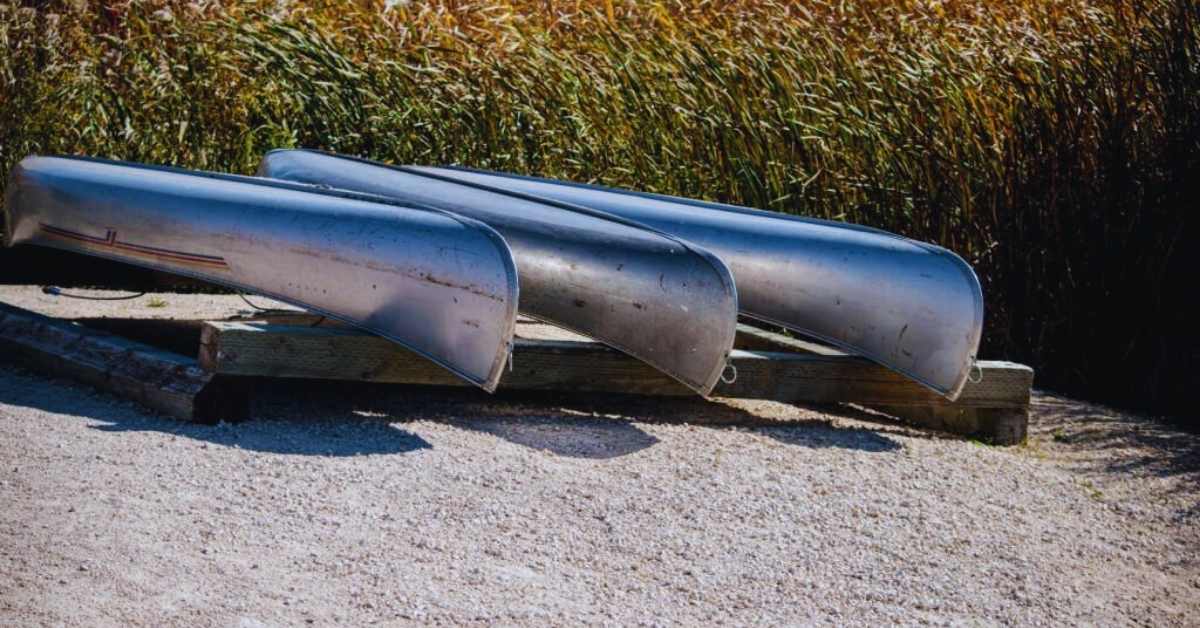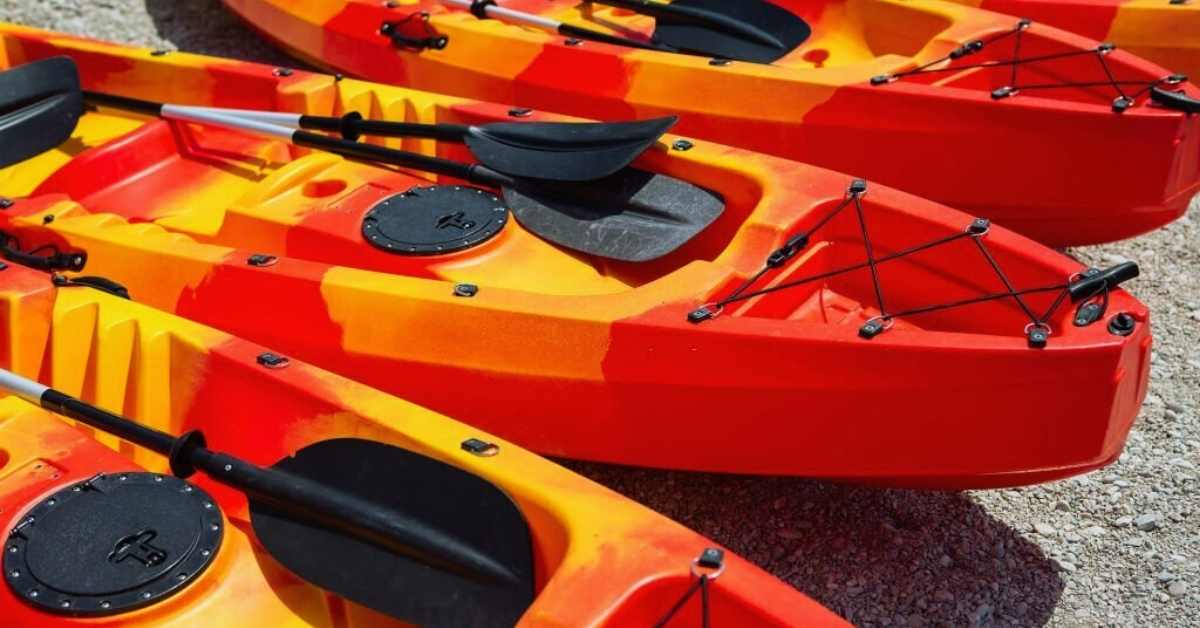Two of the most common materials for outdoor canoes are aluminum and fiberglass. It’s important to know which material is best for your requirements since each has pros and cons.
We’ll compare aluminum and fiberglass canoes in many critical areas to help you choose.
Table of Contents
Aluminum VS Fiberglass Canoes
Aluminum and fiberglass are popular canoes. Each material is ideal for varied canoeing experiences because to its benefits and drawbacks.
Aluminum boats are durable and ideal for trekking across rocky rivers and streams. Fiberglass canoes are lighter and sleeker, making them easier to handle on calm lakes and waterways.
If you’re a thrill-seeker or a leisurely paddler, knowing the differences between aluminum and fiberglass canoes is essential to choosing the proper one.
1. Weight
Here weight comparison Aluminum and Fiberglass Canoes:
Aluminum
Aluminum canoes are lightweight, making them a good choice for canoeing. Aluminum canoes are manufactured from thin aluminum sheets, making them light yet strong.
They are lighter than wooden or fiberglass canoes, making them easier to steer on the water.

Aluminum canoes are lighter and simpler to put into a roof rack or carry from the vehicle to the lake.
This makes them popular with outdoor enthusiasts who go on distant expeditions or transport their boat great distances. Weight is a major benefit of aluminum canoes, making them a popular option while canoeing.
Fiberglass
Fiberglass canoes are lightweight and durable. Composite material fiberglass is woven fiberglass cloth impregnated with resin.
This combination makes a sturdy, lightweight canoeing frame. Fiberglass canoes are lighter than aluminum or wood, making them simpler to move and manoeuvre on and off the water. Depending on length and design, fiberglass canoes weigh 45 to 70 pounds.
This makes them popular among portable and efficient paddlers. A lightweight fiberglass canoe may minimize fatigue and improve your paddling experience on a day trip or multi-day journey.
2. Durability
Here durability comparison Aluminum and Fiberglass Canoes:
Aluminum
Aluminum is durable, especially in canoes. Aluminum canoes are popular among outdoor enthusiasts for their ability to navigate rough waters and challenging environments. Aluminum canoes can withstand hits, pebbles, and inadvertent accidents.
Aluminum canoes also resist UV radiation, rust, and corrosion, making them durable. These canoes are great for water adventurers since they don’t wear out or break quickly.
Aluminum canoes are stable and reliable, making them ideal for beginners and experts. Aluminum canoes are ideal for water-based adventures due of their durability.
Fiberglass
Fiberglass is durable, particularly for canoes. Strong and durable fiberglass canoes are famous. The fiberglass layers and resin make a strong construction that can handle outdoor activities.
Fiberglass is ideal for water sports since it doesn’t rust or corrode like wood or metal.

UV-resistant fiberglass boats don’t fade or degrade over time. The fiberglass canoe resists splits and punctures from turbulent seas and inadvertent hits with rocks and branches.
Fiberglass canoes are great for water exploration since they blend lightweight, strength, and resistance.
3. Maintenance
Here maintenance comparison Aluminum and Fiberglass Canoes:
Aluminum
Taking care of aluminum canoes is vital for their durability and performance. Regular maintenance helps prevent corrosion and structural damage.
It is recommended to clean the canoe with a mild soap and water solution after each use, avoiding abrasive materials that may scratch its surface.
Furthermore, it’s important to carefully inspect the canoe for any signs of wear or damage, such as dents or cracks, and address these issues promptly. By properly maintaining aluminum canoes, you can ensure they remain functional and enjoyable for many years.
Fiberglass
Taking care of fiberglass canoes is essential for their durability and performance. It’s important for owners to regularly inspect their canoes for any damage or signs of wear, and address any issues as soon as possible.
This may involve fixing cracks or holes, refinishing the exterior through sanding, or replacing damaged parts.
Proper storage and handling of the canoe also play a role in its maintenance. By following these guidelines, owners can ensure that their fiberglass canoes stay in great condition and offer many years of enjoyable use.
4. Cost
Here cost comparison Aluminum and Fiberglass Canoes:
Aluminum
Cost matters when buying aluminum canoes. Aluminum canoes are lightweight, durable, and stable on the water.
Brand, size, and amenities affect aluminum canoe prices. Aluminum canoes are cheaper than fiberglass or Kevlar. Starting around $500 to $800, aluminum canoes are affordable for beginners and infrequent paddlers.
However, a high-performance aluminum canoe with modern features and design might cost $2000 or more. An aluminum canoe is a smart purchase since it is durable, versatile, and fun to paddle for outdoor lovers.
Fiberglass
Cost is a major consideration when buying a fiberglass canoe. Brand, size, and features affect fiberglass canoe prices.
Fiberglass canoes are more costly than aluminum or plastic ones owing to their durability and light weight. High-quality fiberglass canoes cost $800–$3000.

Although this seems costly, consider the long-term advantages and pleasure of a fiberglass canoe. Fiberglass canoes survive for years with careful care, making them a good investment for outdoor lovers.
Fiberglass canoes are very attractive due to their streamlined form. Fiberglass canoes are ideal for lake paddles and whitewater experiences due to their performance, durability, and style.
5. Performance
Here performance comparison Aluminum and Fiberglass Canoes:
Aluminum
Aluminum canoes may not be popular with ardent paddlers, but they function well and are unusual. Aluminum canoes can resist whitewater rivers and rough coasts due to their strength. The strong structure allows these boats to withstand collisions and harsh handling without harm.
Aluminum canoes are stable, making them perfect for families and novices. Wide, flat bottoms provide paddlers stability and confidence on the water.
Aluminum canoes can carry more gear and supplies on lengthy excursions. Aluminum canoes are durable and can resist time and adventure, even if they are heavier than fiberglass or kevlar.
Fiberglass
Performance is where fiberglass canoes excel. These lightweight boats glide across the water and are fast and maneuverable.
The sleek design of fiberglass canoes reduces drag and maximizes performance. Fiberglass canoes are ideal for extended adventures and racing since paddlers can cover greater distance with less effort.
Fiberglass is strong and durable, so these boats can tolerate diverse water conditions without affecting performance.
Fiberglass canoes are sensitive and nimble, enabling paddlers to boldly face any adventure, whether on placid lakes or whitewater rapids.
6. Appearance
Aluminum
Aluminum canoes are durable, functional, and attractive. The sleek, polished aluminum canoe surface is appealing, reflecting the landscape like a mirror on water. Its silver color makes it a popular option for modern or futuristic waterwear.
Aluminum canoes exude beauty and refinement with their clean lines and smooth edges. Whether sailing over tranquil lakes or battling tough rapids, an aluminum canoe stands out.
Fiberglass
Besides being practical and effective, fiberglass canoes look great. Recreational and competitive canoeists choose fiberglass canoes for their sleek, contemporary style.
Fiberglass offers the canoe a sleek, professional look on the water. Additionally, fiberglass may be molded into distinctive and eye-catching forms and patterns.
FiberGlass boats come in a variety of colors and patterns to suit individual tastes. Fiberglass ensures that the canoe’s gorgeous design lasts for years, making it a great investment for people seeking both usefulness and aesthetics.
Final Decision Which Is Right For You
Choosing between aluminum and fiberglass canoes depends on your requirements and tastes. Both materials offer benefits and drawbacks.
Aluminum canoes are strong and appropriate for turbulent waves and rugged terrain. Their minimal upkeep and impact resistance make them durable. However, fiberglass canoes are lightweight and simpler to move.
They also perform well on the water due to their sleek and smooth design. Fiberglass canoes may need additional maintenance to prevent sharp objects or accidents.
The intended function, budget, and personal preferences for weight, durability, and aesthetics should determine the choice. I recommend you aluminum canoes right for you but the final decision is for your hand.
| Feature | Aluminum Canoes | Fiberglass Canoes |
|---|---|---|
| Weight | Heavier | Lighter |
| Durability | Durable | More durable |
| Corrosion resistance | Resistant to corrosion | Not as resistant to corrosion |
| Cost | Less expensive | More expensive |
| Noise | Noisier | Quieter |
| Heat retention | Can heat up in the sun | Does not heat up as much |
| Customization | Less customizable | More customizable |
| Maintenance | Requires less maintenance | Requires more maintenance |
Conclusion
The choice between an aluminum and fiberglass canoe ultimately depends on your specific preferences and intended use.
Aluminum canoes are a practical and durable choice for rough conditions and budget-conscious buyers.
Fiberglass canoes offer a smoother and lighter paddling experience but may require more maintenance and come at a higher cost. Consider your priorities, budget, and the type of paddling you plan to do before making your decision.
